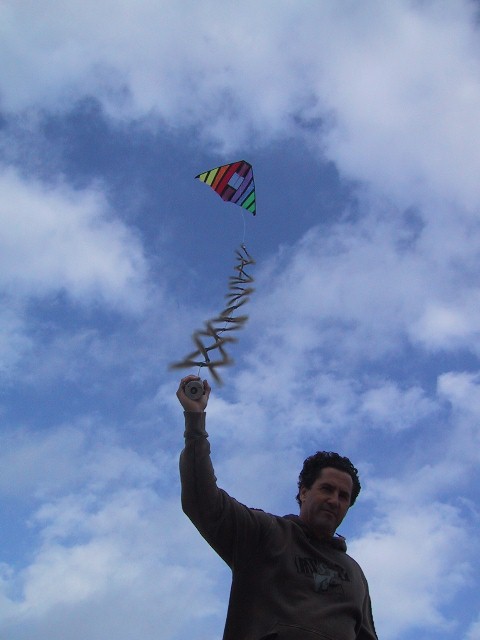|
 Multi
Autogyro Rotors On One Line Multi
Autogyro Rotors On One Line

Ganged turbine rotors along a common axis is an old idea. Doug Selsam
has kept the scheme active on the AWE forum with his SuperTurbineŽ, based
on torsional power transmission.
SkyMill's concept begins as a single
autogyro rotor modulating tug on one line, but there is no critical
barrier to putting may such rotors on one line, boosting power.
The simplest method is to give each rotor its own section of leader line
and connect rotors much as an ordinary kite train is built. A bit more
complex would be rotors that can thread onto a continuous line and climb
or descend as an independent carriage (kite messenger).
The topmost element could be an electric helicopter to initiate early
launch to altitude and decelerate landing. This may well be a general
AWECS launch solution.
The Multi Autogyro method offers high operational flexibility. It greatly
multiplies the potential power of autogyro-based AWE, while avoiding
difficulties of torsional power transmission.
CoolIP
~Dave Santos Aug.
14, 2011
M3946
Comment and development of this topic will be occurring here.
All, send notes, drawings, and photographs!
Terms and aspects:
- Early air and water patents for multiple rotating elements on one
tether:
Related links:
Commentary is welcome:
- Interesting way. But on SkyMill the tether is several km,and the
direction of winds differs according their height. The management of
different directions of wind could be difficult, except (?) in the case
where only rotors in the same wind direction are working. ~
PierreB
http://flygenkite.com
- At first consideration, such a scheme presents very attractive
power-harvesting attributes. That said, my guess is, as far as our
SkyMill type application goes, the "devil's in the details" for such a
scheme, i.e., the orchestration of passing high tensions along such a
chain of tethers will be (if lacking some highly inventive scheme that
would allow this occur in a simple reliable operational fashion) fraught
with many detail design/operational obstacles. ~DaveL
- DaveL, Every scheme that
has multiple flight "agents" working in a coordinated fashion has added
control complexity. SkyWindPower describes a flock of close-flying
units, presumably to avoid surface sprawl of widely spaced units.
KiteGen also depicts coordinated flight in its stem farm and carousel
animations..
Fortunately, ganging units along a common line is a less complex way to
aggregate power. A misbehaving unit is constrained by all the others,
carried along rather than causing mayhem. The model of a tug-o'-war
suggests reasonably tame collective dynamics, although one can envision
fancier harmonics, like multiple traveling waves pumping the surface
work-cell.
A basic "long-line" AWE principle seems to be emerging; that lift might
as well be harvested all along a kiteline, rather than bypassing a bunch
of lift to only get it at some higher altitude.
I also see "SkyMill Trains" as a competitive harvesting units under a
potentially far larger cross-linked lifter array, for gigawatt-scale
energy production, ~DaveS
- DaveS, I am not as concerned about "group stability" (since
active control for each rotor is at our disposal) as I am about other
"devils in the details". For instance, I am referring to things like the
"Ball-swivel" you refer to, or the launching and retrieval of such a
chain of rotors.
~DaveL
- DaveL, Lets forget the
ball-swivel then, it adds little value.
The more fundamental open question is whether it is easier (or cheaper,
safer, etc.) to launch multiple standalone autogyro units versus
launching multiple units along a "pilot-line" for equivalent power.
~DaveS
- Dave, are there some links to see these contraptions in action?
~Darin Selby
Aug. 15, 2011
- Darin, This is not a "contraption" in the Rube
Goldberg sense of messy complexity, but a reasonably "clean" modular
design.
This scheme looks just like Doug's demos of many rotors on a kitestring.
The slight visual difference is the line is tugged, not torque,
~ DaveS
- Wouldn't a
contra-rotating blade arrangement stabilize your airborne generator
from precession forces? ~DarinS
-
 click through image for full patent.
click through image for full patent.

Click image above for full patent.
- Enjoy a Dave Santos drawing
here
- And shown is a Selsam hand-held
electricity-generating torque-tether multiple rotors on single line with
lifter pilot kite. He is holding the generator.
-

-
- Follow a related discussion in forum:
AirborneWindEnergy/topics/3946 and following.
|

